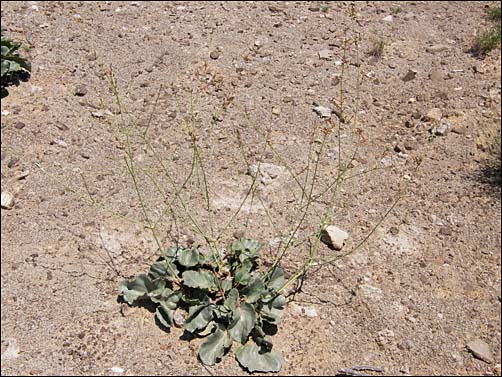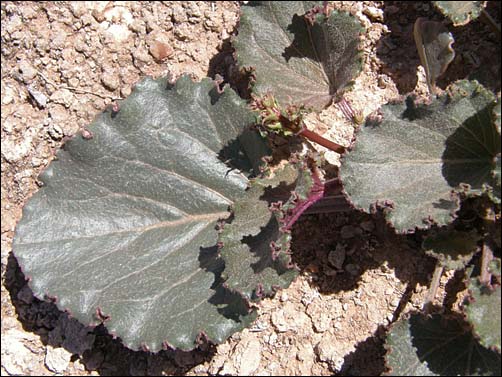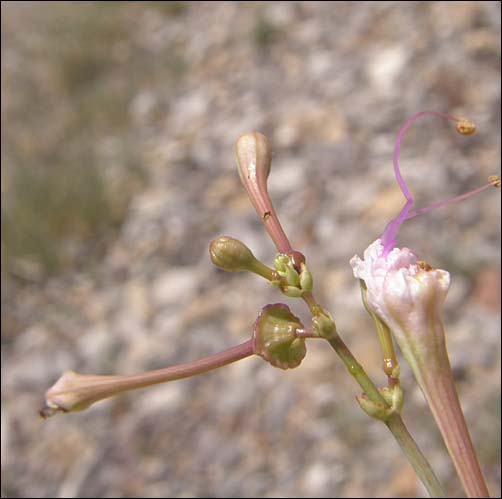Southwestern Ringstem (Anulocaulis leiosolenus), varieties gypsogenus and leiosolenus
Anulocaulis leiosolenus var. leiosolenus
Overview, foliage, and flower, Coahuila, Mexico. Photographs by Wynn Anderson.
- Common English Names: Gyp Ringstem
- Common Spanish Names: None known
- Scientific Name: Anulocaulis leiosolenus v. gypsogenus (ann-noo-low-CALL-us lie-so-LEN-us var. jip-so-GEE-nus)
- Family: Nyctaginaceae (Four-O'clock Family)
- Geographic Range: Restricted to gypsum rich soils along the Pecos River from Roswell in Chaves Co., New Mexico, south into northern Culberson and Reeves counties in Texas.
- Description: Stout perennial herb rising from a gnarly woody rootstock with large, coarse, mostly smooth or with scattered pustulate (swollen base) hairs, glaucous blue-green to gray-green or dull green basal leaves, a few largely leafless 3-5 foot long stems, loosely branching into open panicles terminated by scattered solitary or few flowered clusters of 1-inch long funnel-shaped flowers, white, pale pink to rose pink in color, often with darker rose to magenta exerted filaments. A nocturnal bloomer, the flowers opening at dusk and closing by mid-morning. In this variety, the leaves are pale blue-green, smooth and without hairs (glabrous). Flowers are white to pale pink, buds (tips) are hairless.
- Notes: One of four described varieties of this species. Ringstems are named for the often pronounced, viscid, sticky, sap-like ring that encircles the elongated stems between joints of the inflorescence of this and several other members of the plant family. The purpose of this feature is unknown, but it often traps and holds small insects as well as dust and tiny particles of wind-blown debris and may well be a means of providing additional nutrients at flowering time.
Anulocaulis leiosolenus var. leiosolenus
Southwestern Ringstem, overview, Clark Co., NV. Photograph by Wynn Anderson.
- Common English Names: Southwestern Ringstem
- Common Spanish Names: None known
- Scientific Name: Anulocaulis leiosolenus var. leiosolenus (ann-noo-low-CALL-us lie-so-LEN-us var. lie-so-LEN-us)
- Family: Nyctaginaceae (Four-O'clock Family)
- Geographic Range: On alkaline clay bluffs and gypsum soils along the Colorado River in southern Nevada and northwestern Arizona, and on calcareous shales and clay along the Rio Grande in south-central New Mexico to western Texas and adjacent Chihuahua, Mexico.
- Description: Stout perennial herb rising from a gnarly woody rootstock with large, coarse, mostly smooth or with scattered pustulate (swollen base) hairs, glaucous blue-green, to gray-green or dull green basal leaves, a few, largely leafless 3-5 foot long stems, loosely branching into open panicles terminated by scattered solitary or few flowered clusters of 1-inch long funnel shaped flowers, white, pale pink to rose pink in color often with darker rose to magenta exerted filaments. A nocturnal bloomer, the flowers opening at dusk and closing by mid-morning. In this variety, the leaves are dull green with a moderate scattering of pustulate hairs, flower color is white to pale pink, and the buds (tips) are without hairs.
- Notes: One of four described varieties of this species. Ringstems are named for the often pronounced, viscid, sticky, sap-like ring that encircles the elongated stems between joints of the inflorescence of this and several other members of the plant family. The purpose of this feature is unknown, but it often traps and holds small insects as well as dust and tiny particles of wind-blown debris and may well be a means of providing additional nutrients at flowering time.

Last Update: 30 Sep 2013





